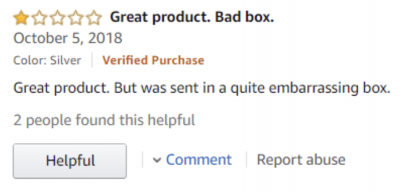How to Remove Fake Reviews on Amazon

Fake and unfair negative reviews on Amazon have been causing serious headaches for sellers, impacting both their reputation and customer base – two crucial factors for online success. In an age where information is easily accessible, managing your brand’s image is more important than ever. This article will explain how to remove fake reviews on Amazon.
Why Negative Reviews Matter
Negative reviews can damage a seller’s credibility, reduce trust in their products, and ultimately lead to lost sales. Even a few unfavorable comments can deter potential buyers, making it vital for sellers to address and resolve such issues promptly.
How to Spot Fake Reviews on Amazon
Does Amazon delete negative or positive reviews in general? Yes – in case they don’t meet Amazon’s guidelines and are therefore considered inappropriate. But before we focus on how to remove such reviews from Amazon, we should take a look at how to find them first. Amazon’s community policy already gives some hints to what kind of reviews are likely to be deleted, for example:
For example, the following review describes packaging and not the product itself, which is against Amazon’s policy.

Spotting fake reviews can be somewhat more tricky because it requires you to keep your mind on several factors at the same time. There are a few telltale signs that make a false review on Amazon stand out from the rest.
Language and Length
In my experience, there are three types of reviewers. Those that had an amazing experience and want to share it, those whose experience was so abominably miserable that they felt the urge to warn others, and those who just want to communicate that “everything went as expected.”
The latter group will normally write one-liners without any specific details, normally just informing other shoppers that it’s “safe” to order from this specific account and that it’s not a scam of some sorts. However, once you see reviews of the first two groups that are only a few words long, you’ll be better off taking a closer look as they might be fake reviews:

On Amazon, once someone is highly satisfied or unsatisfied with a product, they will tend to leave you a reason why they feel that way and go into detail, leaving either a glowing or an extremely bad review.
Amount and Recency
If the reviews for an Amazon product are all quite recent and the amount of reviews is rather small, don’t hesitate to check the reviewer’s profile for authenticity.
The same goes for sellers when checking for fake reviews on Amazon. If you notice that someone, firstly, wrote an enormous amount of reviews, secondly, did so in a short period of time and, lastly, all of these reviews address the direct competition, chances are that there is some dirty play at hand.
Review Ratio and Product Popularity
The review ratio of 5-star ratings in comparison to 1-star-ratings is always a good starting indicator for weeding out which Amazon reviews are fake. If a product has 70% 5-star-feedback in comparison to 30% 1-star-feedback, you might be looking at fake reviews.
Same thing goes for products that have a 100% 5-star rating, but only 11 reviews, as shown in the following example. In this case, I would rather go with a product that has a 4.6-star rating, but hundreds of reviews.

Here’s another scenario: If an Amazon product has been on the marketplace for only two months and has already gathered a thousand reviews, chances are that these reviews were bought.
This goes for customers and merchants alike: When you’re looking for fake reviews on Amazon, keep in mind that it always makes sense to compare the review ratios to other similar products on the market.

Tips on How to Remove Fake Reviews on Amazon
The reality is that reviews are one of the most valuable factors in online shopping, that’s why Amazon is very careful with removing them. Yet, in cases with strong evidence, it is worth reporting them and thereby help eliminate any misleading information. Finding inappropriate positive or negative reviews on Amazon requires no in-depth analysis and no real knowledge about the products themselves. However, reporting the malignant shoppers and reviewers is, unfortunately, a little more difficult. In the following, we’ll take a look at some options of how to report unfair or fake reviews on Amazon.
How to Report Fake Reviews on Amazon
Finding fake reviews on Amazon requires no in-depth analysis and no real knowledge about the products themselves. However, reporting the malignant shoppers and reviewers is, unfortunately, a little more difficult.
The “Report abuse” Button
While buyers can report reviews on the Amazon platform itself – every review features two options at the bottom labeled “Helpful” and “Report”. As a seller, you have the option to do this in your Seller Central account. Simply log in, find the abusive review and click on the “Report abuse” link. This will open a list of reasons why you would like to report this review (e.g. inappropriate content, violation of Amazon’s guidelines, etc.). Select the reason and submit the report.
Amazon has removed the feature where you can write why you found this review inappropriate. However, you can always write an email to [email protected] if you want to voice your concern a little clearer. Mention all relevant information (your product’s ASIN, the date and time of the review as well as the name or nickname of the reviewer) and explain why exactly the review in question doesn’t comply with Amazon’s policy.
Build a Case to Go with Your Email
When you’re defending yourself against fake negative reviews on Amazon as a seller, we strongly suggest that you write an email instead of simply reporting the abuse. Of course, you’ll need to build a stronger case if you want it to be successful. Here’s how you do it:
1. Ask Amazon Seller Support
Yes, we are aware that taking this problem to Amazon Seller Support will mean that the process may take a long time and the results – if there are any at all – will not necessarily be the ones you were hoping for. However, when handling fake reviews on Amazon, this is also the solution that will be suggested to you if you try to escalate the situation immediately. In that case, it can be handy to show the “higher-ups” your case ID and prove that you already followed regular protocol, reaping no rewards.
2. Report to PRA (Product Review Abuse)
If the first part fails because, for example, the Seller Support team has refused to remove those reviews from Amazon, write an email to [email protected]. Be sure to be as descriptive and precise as possible. Emphasize that regular protocol and Seller Support were not able to help you, in what way the reviews violate pertinent guidelines, and also in what way the fake reviews on Amazon are currently hurting your business.
When you receive an answer, don’t be fooled by how short it is (“Thanks, we will look into it”). It may sound like they are brushing you off, but seller experience has proven that – in most cases – the review in question is then removed by Amazon. Have a little trust in the Amazon framework at this point. As we already mentioned, they have a big interest in keeping the review environment as honest as possible too.
How Not to Deal with Unfair or Fake Negative Reviews on Amazon
Many non-FBA sellers have been known to request buyers to remove their reviews from Amazon upon resolving the problem or even offer them incentives of sorts to remove/alter their review.
Do not do this.
Even though it may improve your product rating, it is still against Amazon’s customer review policy, which clearly states that a seller cannot ask a “reviewer to change or remove their review.”
To Keep In Mind: Not All Negative Reviews on Amazon Are Harmful
At first glance, negative reviews on Amazon may seem harmful to your business. However, instead of trying to remove all negative feedback, consider learning from it. Detailed reviews can offer valuable insights, such as highlighting unclear product descriptions that need optimization or the need for better visuals to set accurate expectations. Sometimes, they may reveal quality issues, signaling areas for improvement.

How should you respond to a fair but negative review? Begin by politely acknowledging the feedback, offering an apology, and thanking the reviewer for their honesty. Use this chance to explain your perspective and share useful information for other buyers. If possible, provide a solution to the issue. This approach can even encourage the customer to reconsider and remove the negative review.
Final Thoughts
Reviews are a powerful tool for building trust and marketing your product. That’s why it’s crucial for sellers to promptly address inappropriate reviews on Amazon. The key is to identify these reviews, report abuse, and, if necessary, escalate the issue to Seller Support using your Case ID. While it can be challenging to get Amazon to remove reviews, always follow their protocols and avoid direct contact with reviewers.
Fake reviews can boost low-quality products unfairly, while real but unfair reviews may hurt your ranking and mislead customers. Before this backdrop, Amazon tackles fake reviews using advanced algorithms, manual review teams, and verified purchase badges. They also take legal action, prohibit incentivized reviews, and encourage genuine feedback. Community reporting and transparent policies further help ensure reviews are trustworthy, allowing customers to make informed decisions.
FAQs
To spot fake Amazon reviews, look for overly generic or repetitive language, excessive praise, or reviews that lack specific details about the product. Check the reviewer’s profile for patterns, such as multiple reviews posted on the same day or reviews for unrelated products. Also, be cautious of reviews that are too short or overly lengthy. Suspiciously high ratings with few reviews may also indicate potential fake feedback.
Studies estimate that around 30% to 40% of Amazon reviews may be fake. A report by Fakespot, a company specializing in detecting fraudulent reviews, found that the percentage of inauthentic reviews can vary by product category, with electronics, supplements, and beauty products often having higher rates of fake reviews. While Amazon continuously works to combat this issue, fake reviews remain a persistent problem across the platform.
To remove fake Amazon reviews, start by identifying reviews that clearly violate Amazon’s guidelines, such as those that are deceptive, promotional, or irrelevant. Use the “Report abuse” option next to the review and provide a detailed explanation of why it’s fake. You can also contact the Amazon Seller Support to open a case, supplying evidence to support your claim. If needed, escalate the case using your Case ID for further review. Always adhere to Amazon’s protocols and avoid contacting reviewers directly.
Image credits in order of appearance: © SpaceOak – stock.adobe.com / © Atipong – stock.adobe.com / Amazon.com / © StockPhotoPro – stock.adobe.com






